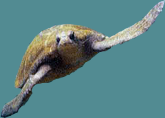Introduction to Waste on the Islands
Waste management in the Galápagos is an issue that has only been of significant concern the last thirty years as populations bourgeoned and imports from the mainland expanded. The two types of waste addressed in this proposal will be water born wastes and those associated with organic or inorganic trash. Beyond being a problem the islands do not deserve to have, waste management presents an opportunity to stabilize the economy, beautify the villages, pacify the local residents, and address some of the environmental impacts associated with human habitation on the islands.
Today, the three large villages on Isabela, Santa Cruz, and San Cristobal are equipped with a wide array of waste treatment facilities. The plant on Isabela is highly inefficient and attached to a piping system that has been in place since 1970. As a result, the water that passes through this system back to the houses has an average coliform content of 300 ppm. Within the urban centers, 44% of the houses are attached to the sewer system while septic tanks are used in 56% of the houses. (Ley, 2002) Both Santa Cruz and San Cristobal have much less formal waste management facilities structured around a series of canals running between the houses in combination with outhouses.
Garbage, both organic and inorganic, is also a question of concern on the islands. While recycling programs have been implemented, and significant improvements made, the underlying problem is yet to be addressed.
Organic and Inorganic Waste Collectede
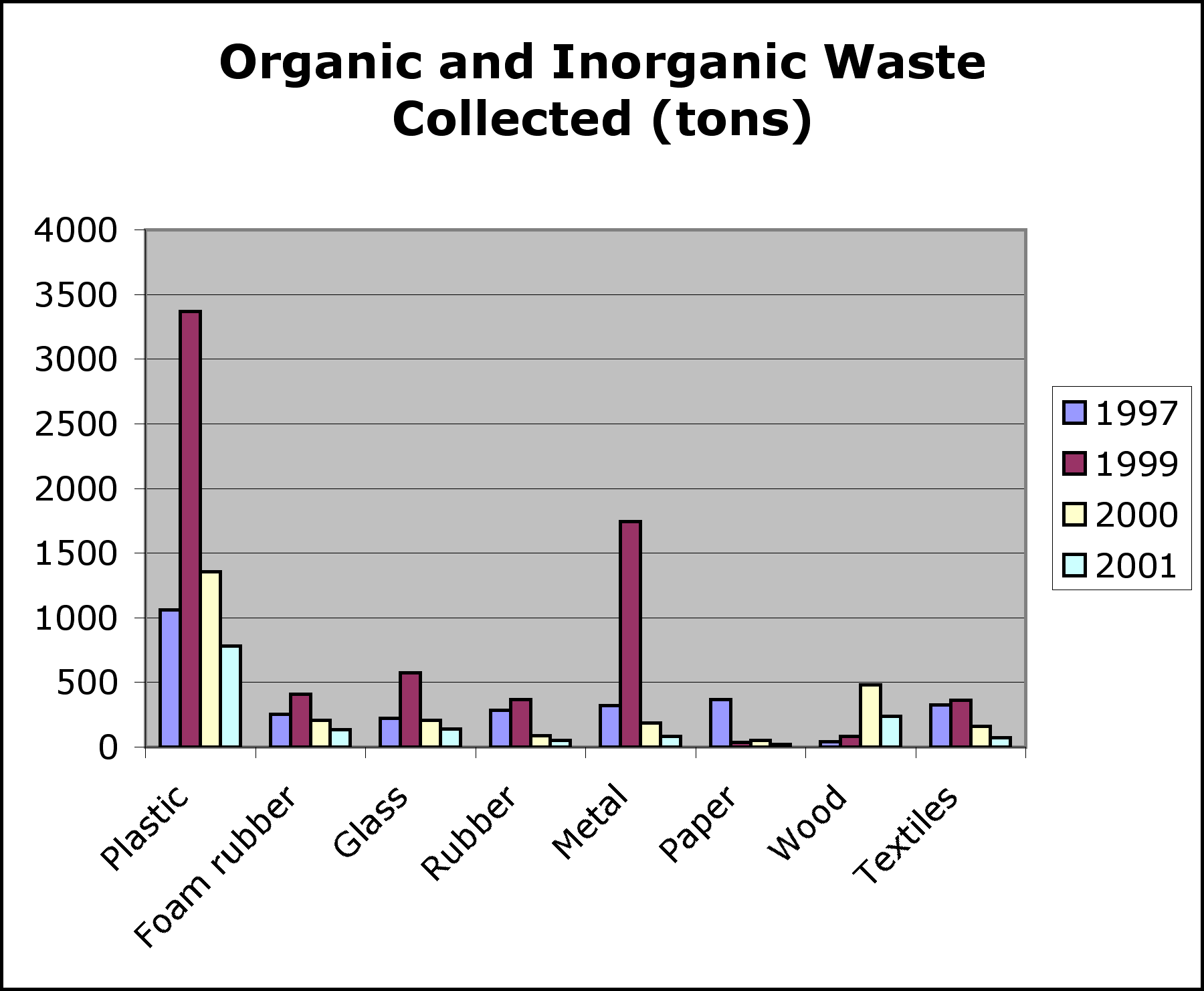
(John Todd Research and Design, 2004)
It is therefore the intent of this report to articulate how best to avoid the production of such waste in the first place, and then to address how, where such waste are generated, to best assure that they are properly processed.
With the progression of time, waste produced per person has increased significantly both in total mass and percent inorganic composition. In 2000 on the island of Santa Cruz, this value was set at 0.74 kg per person per day, 0.93 for San Cristobal, and 0.52 for both Isabela and Floreana. (Ley, 2002) Projections are set for 2020 that suggest these numbers will rise to 1.05, 1.05, 0.7, and 0.7 respectively for Santa Cruz, San Cristobal, Isabela, and Floreana assuming development continues at its current rate. (Ley, 2002)
[top]
Our Vision for Waste on the Islands
Ideally, total waste for the islands should be determined simply by summing over the shipping materials and energy used to bring imports to the islands. While such a vision remains a moderately distant future, we propose a system where by all waste generated on the islands can either be used as for as a new source of profit or processed on the mainland at a recycling facility. Within Ecuador, the black sheep in provides a model for such a future as an institution where each guest and employee generates no more than one ounce of waste per day
1.
[top]
LivingMachine Technology
Living machine technology was developed about thirty years ago by Dr. John Todd, and since has demonstrated incredible capacity to maximize use of natural processes to close material loops. Analysis of one such system in Burlington, VT constructed and designed by John Todd Research and Design demonstrates the effectiveness of this system:
TSS Treatment Performance
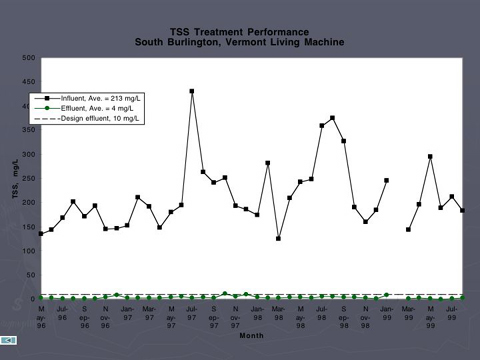
(John Todd Research and Design, 2004)
CBOD Treatment Performance
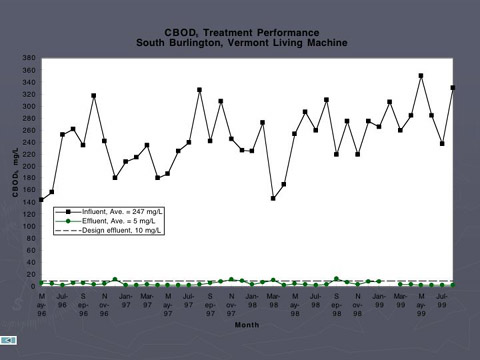
(John Todd Research and Design, 2004)
Ammonia Treatment Performance
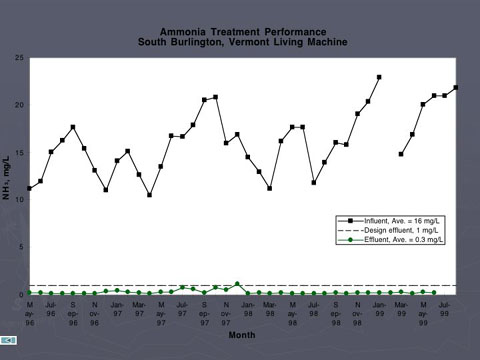
(John Todd Research and Design, 2004)
The basic idea is that you take the natural process through which waste decomposes and compress the time frame. Water based systems begin with a microbial tank which in turn takes the waste through a series of tanks of increasing taxonomical complexity. The resulting solution is the filtered, with the solid component ready to be used as fertilizer in systems run on grey water. The liquid component flows into a natural wetland tank that completes the filtration process by eliminating remaining toxins and unwanted minerals, and then passes the water base on to a holding tank where it is exposed to sunlight (UV radiation) for finally sanitation.
Example of such a system
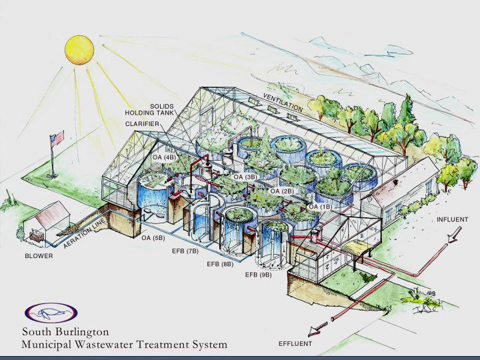
(John Todd Research and Design, 2004)
[top]
Why use a living machine in this case
Living Machine design is a perfect resolution to a potentially nasty problem, made even better by the fact that it employs whole systems design, is a biological process, and embodies the potential in symbiotic relationships. Given that the islands are key to the development of evolutionary thought, it makes sense that the solution to inefficiencies is an application of the immense store of knowledge accumulated over the centuries in the form of ecological balance.
Living Machine design provides the additional advantage of existing as an organ for economic development and education
2. Fish, endemic species, and smaller fruits or vegetables can all be harvested from the living machine by the residents and sold in the market. The most significant advantage of such a shift would take pressure off of the humid zones and marine reserve to fulfill the island’s subsistence needs. Due to its central location and open air presentation, the entire process can be used as an educational opportunity on the ecology of the Galápagos, as well as a demonstration of its beauty and diversity.
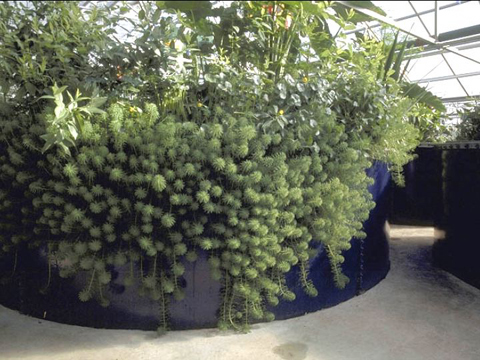
(John Todd Research and Design, 2004)
[top]
Urban Design for Isabela, Santa Cruz, San Cristobal
The designs used on Isabela, Santa Cruz, and San Cristobal will all be modeled on a similar pattern. The entire living machine system will run on salt water
3. Wide pipes will be used to transport waste from the individual houses to ground level where they will then be transported to the living machine where the mixture will be processed. All species used in the living machine will be endemic, with particular emphasis going to species such as the mangrove that is endemic, endangered, and one of the world’s best salt water purifiers.
Mangroves
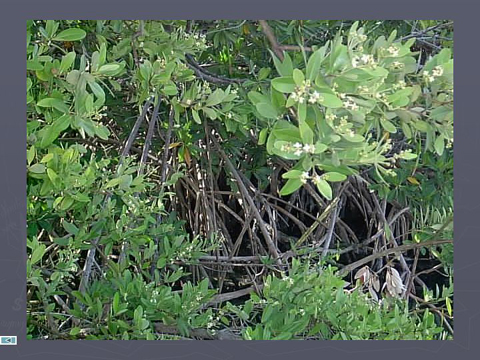
(John Todd Research and Design, 2004)
After going through the entire system, the cleansed salt water will enter into a chamber that concentrates sunlight to speed up the natural water cycle, thus drawing off the fresh water for either drinking or cooking. The easiest means of achieving this separation would be to have a large, shallow pool covered by a mildly sloping domed roof with a secondary internal skin attached like an interior skin around the edge to catch the water as it precipitates. There are also more complicated material intensive plans to achieve a similar end where mirrors are arranged such that they focus sunlight on a water tower such that as the water reaches the top of the arrangement it vaporizes, condenses, and then falls back as saturated salt water and fresh water along two parallel external tracks. The saturated salt mix will then be dried completely and salt sold both locally and to larger external food processing organizations.
Grey water will be carefully managed to maximize benefit per unit freshwater. All soaps used will be biodegradable and of a variety easily metabolized by the plant life on the roofs of the houses
4. During the rainy season, grey water will be processed through the same living machine system as sewage. During the dry season, it will be used to maintain the green roofs and green spaces between the parallels with. In the second case, all excess grey water will go through the living machine.
Looking at capacity, it would be possible to build composting toilets and use the residual from these as fertilizer (although in such a system we might just have too much). This is something done regularly in South America, although it does not seem something that happens often in Galápagos. The issue that comes up here is two fold: one – it can be a less pleasant and work intensive job to maintain these units, and b, it requires digging a bunch of holes to accommodate the relatively large population and as a result would take up a lot of space. People like to see the world as a forward moving place, and while using biological processes is indeed the pinnacle of such thought, the beauty of such processes is not as apparent when it happens under ground.
[top]
Excess Sewage Waste
Should excess biological material becomes a problem, there are a few additional options beyond living machine or composting designs that could work really well. Studies have been carried out on to determine the potential for biomass energy generation and found to be applicable in the highlands for both Santa Cruz and San Cristobal. This could potentially be used to provide on site energy for some of the farming equipment, to heat water, and reduce some of the biological waste to fertilizer. Maybe there are even some interesting endemic bacteria on Galápagos that would be more efficient biomass facilitators than those already in use and we could have a positive impact in other parts of the world by exploring a bit. In talking to the individual in charge of sustainable agriculture, he promised pictures of their bio digesters, so I am assuming from this that some biomass generative capacity is already in place and so would be easy to expand upon. Biomass is also covered in the energy curriculum they have drawn up for school children and others learning about renewables, and seems to be well accepted by the population.
Excess sewage waste could either be composted or kept in a holding tank. A better solution here would be to divert all grey water flows from the living machine when it looks like you might be approaching capacity. This should be an automated response. Grey water can be used to water the green roofs or other public spaces, assuming we work out the provision of biologically sound soaps and the like. This would of course be something to monitor. When there is not enough waste flow through the living machine, grey water could be processed with the rest.
Non-biodegradable waste like plastics should all be recycled and sent to the mainland as is presently done. The same goes for anything we can’t use. Read the recycling proposal if you are interested in how we incentivize recycling. Inorganic non-recyclables should generally not be allowed on the islands. Where they do exist, these could either be burned as is now done or sent back with the recyclable material to the mainland. Again, read the waste proposal.
Biomass is accepted, clean, onsite, already done, makes fertilizer and would use all pieces of the excess biological waste. Freshwater is precious, so grey water is precious. Reuse is a good thing where at all possible. Recycling is important. Finding a way where it benefits the people to recycle more directly than simply improving he environment is even better as it adds to our goal of stable economy and involved citizenry.
[top]
Organic and Inorganic waste management
Waste that is not sewage: Some mention was made of this in the question: what to do with excess waste? Organic waste will either go to fuel a digester or be composted. Wood will likely find a new life in the form of furniture and the like. Fabrics could be used as insulation. Generally, inorganic waste (whether it is collected recycled materials or hard waste should be sent back to the mainland. Right now it either goes in a landfill on San Cristobal or is burned. While its fate will be similar on the central island, why not employ and elsewhere just this once and just in a very slight number of instances. Encouraging the local population to assist in waste management will follow a line of thought and practice modeled after that used in Curitiba, Brazil. In this example, poorer residents collected and sorted garbage around their homes, combining this with that which they accumulated during the regular progression of their lives and then exchanged these items for food tickets, books, and toys. (Hawkens et al., 1999) In our own situation, exchange could be made for education, solar cookers, building materials, or other items of particular use to the resident population. Of course the ideal situation would be one where there would be no need to ship anything back to the mainland, as all products would be used and re-used as function with a wide array of purposes. (The example of Curitiba is outlined in chapter 14 of the book Natural Capitalism and its very own book entitled Curitiba just published in 2004.)
[top]
Sources
- Hawken, P., H. L. Lovins, A. Lovins (1999). Natural Capitalism. Little, Brown and Co: New York.
- Todd, N. & J. Todd (1984). Bioshelters, Ocean Arks, City Farming. Sierra Book Clubs: San Francisco.
- Todd, N. & J. Todd (1993). From Eco-Cities to Living Machines. North Atlantic Books: Berkeley, CA.
- Information on the Black Sheep Eco-Lodge can be found at: http://www.blacksheepinn.com/
- Personal Communication John and Jonathan Todd (November 26, 2004).
- Currently a salt-water based living machine is used in the Four Seasons Hotel in Hawaii.
- Castile soaps as well as many varieties of outdoors soap are environmentally benign and easily purchased in bulk.
[top]
Copyright!
All rights reserved.
Webmasters



